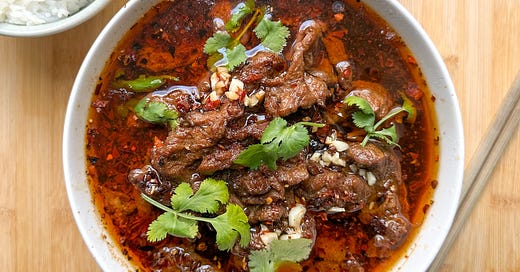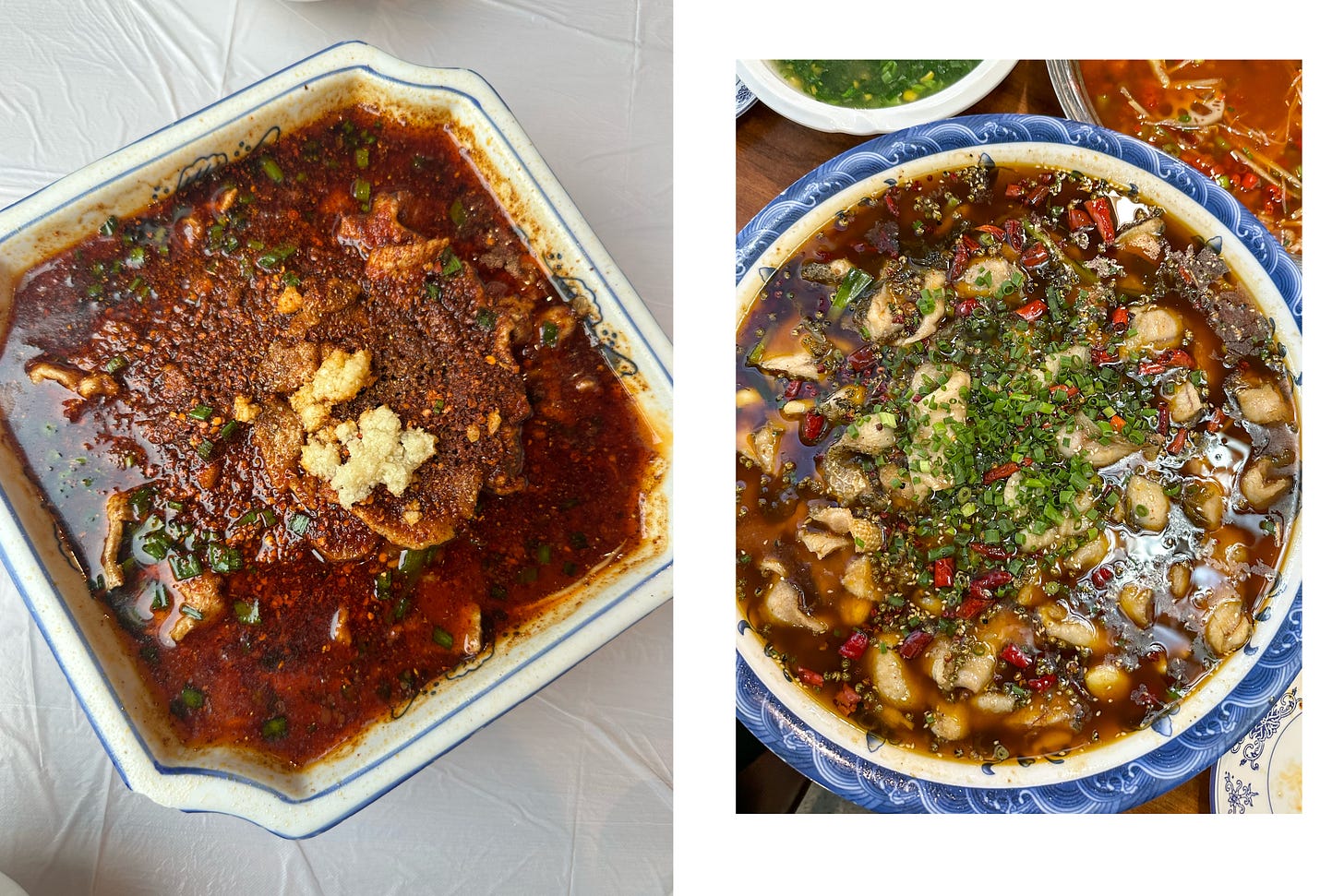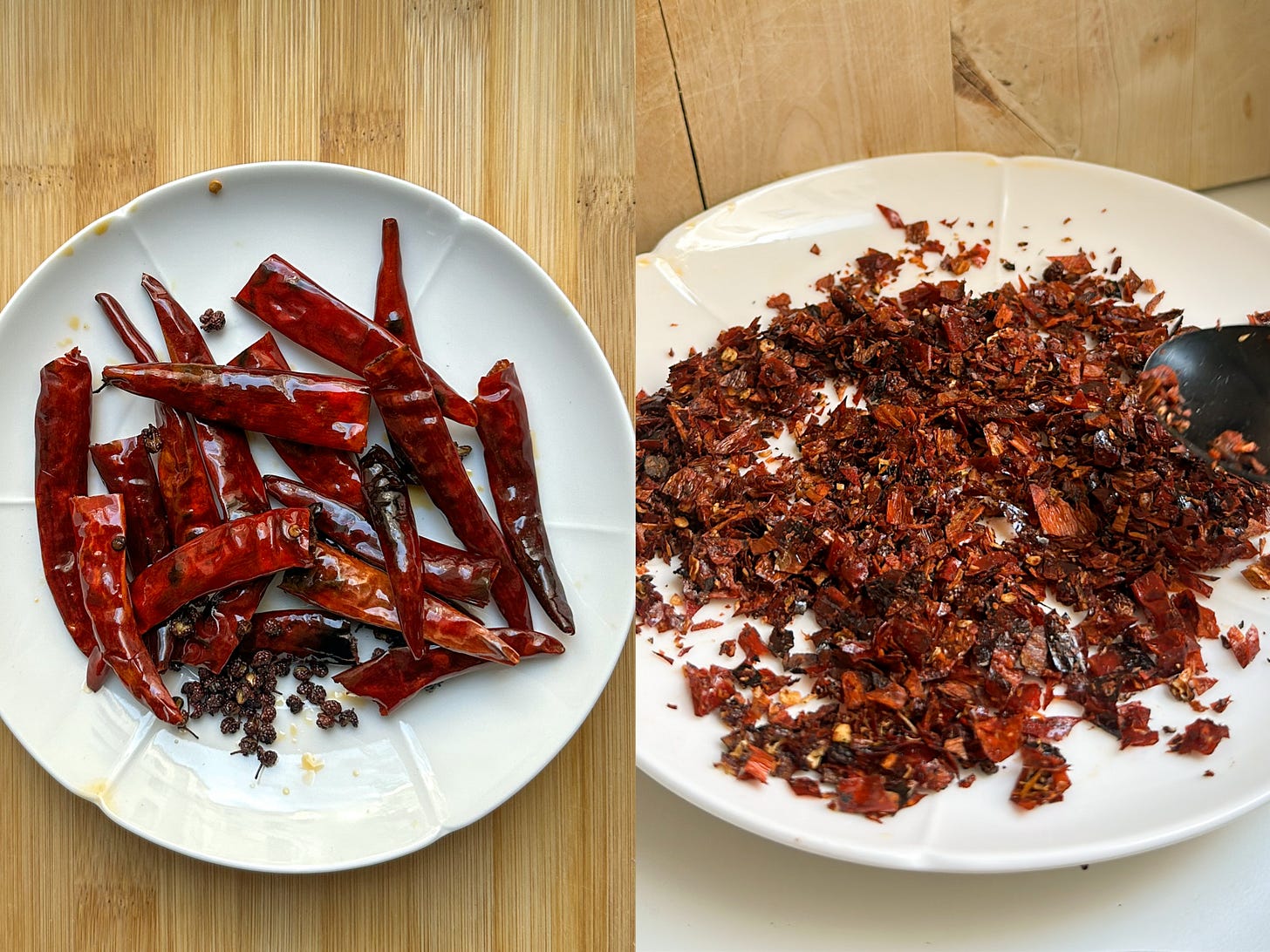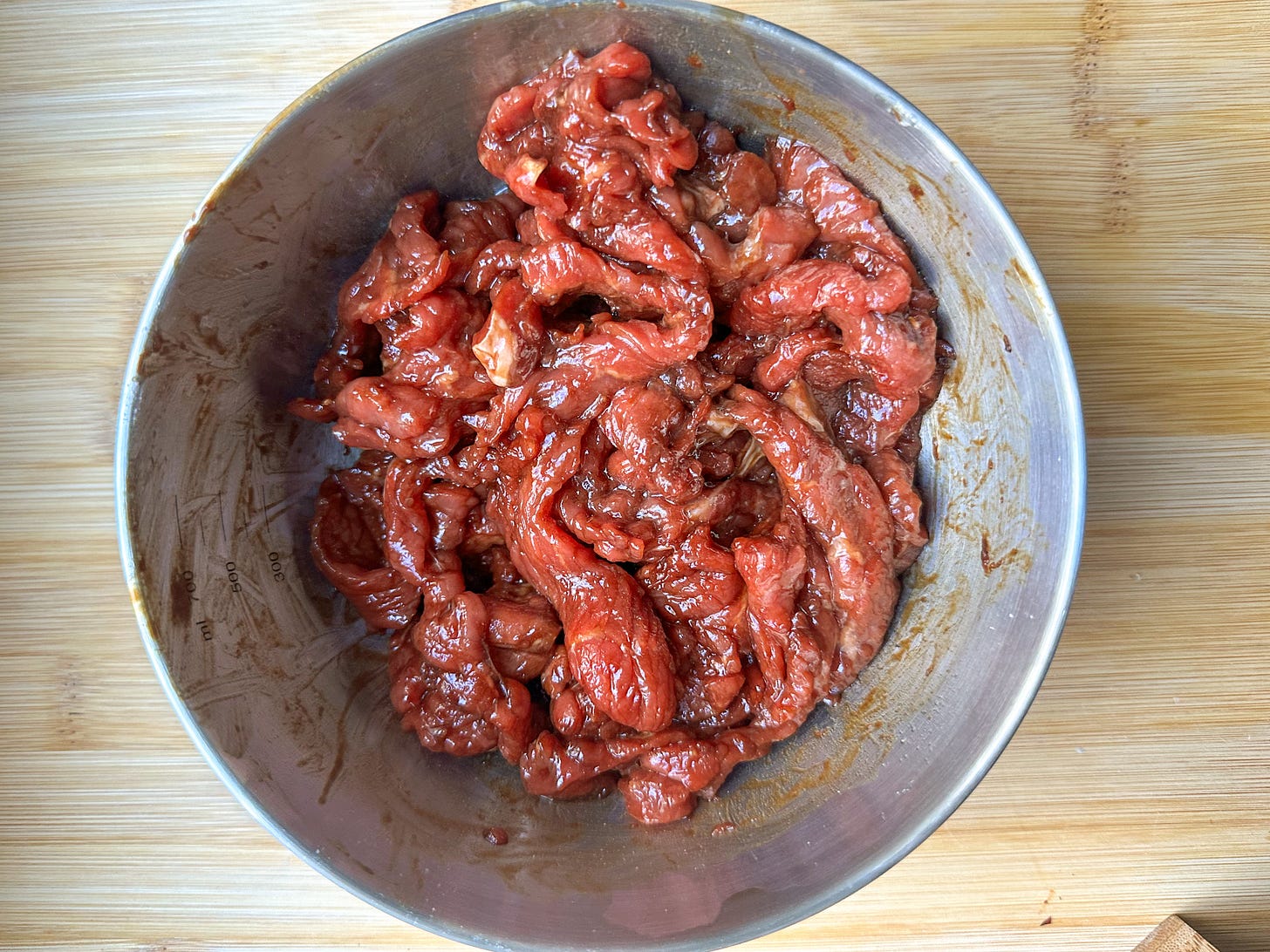During my early years as a student in Berlin, my occasional treat was traveling to the west side of the city near Kantstrasse, where most Chinese restaurants were clustered, to satisfy my cravings for Chinese food. My rule of thumb was to order dishes I couldn’t possibly recreate in my tiny dormitory kitchen—where the bed was just a few steps from the stove—and, of course, with my then-limited cooking skills. Water-boiled beef—shuizhu niurou (水煮牛肉), or its fish variation—was one of those indulgences.
Although many Chinese restaurants in Germany at the time served a broad, pan-Asian selection, this fiery Sichuan dish was almost always on the menu. Even when dining alone, I would enjoy a steaming bowl of shuizhu dish with some white rice, patiently fishing out the tender beef slices and vegetables soaked in the scrumptious red broth, my face covered in sweat from the heat.
I tend to divide Chinese food into two categories: home cooking and restaurant dishes. For example, deep-fried whole fish was strictly a restaurant dish. Water-boiled beef fell into the same category for the longest time until I started experimenting with more Sichuan recipes at home. After a few attempts, I quickly realized that making this dish wasn’t as complicated as I had imagined.
A Brief History of Water-Boiled Beef
This dish consists of thinly sliced beef, briefly blanched in a spicy, numbing broth made from doubanjiang (fermented bean paste), dried chilies, and Sichuan peppercorns. Its seemingly harmless name—"water-boiled beef"—belies its bold, fiery punch. On the Sichuan spiciness scale, it ranks pretty high.
Water-boiled beef originated in Zigong, Sichuan, a city historically famous for its salt mining and trade. It belongs to a popular branch of Sichuan cuisine called Salt Gang Cuisine (盐帮菜), which is known for its bold flavors and generous use of chilis and aromatics. In Zigong’s salt wells, thousands of oxen were used for transport and to drive the machinery. Once the cattle aged and were no longer useful, their meat was sold at extremely low prices. Salt workers would grill the meat or boil it in salted water, serving it with dried chilies.

According to food historian Lan Yong, the dish was refined by the renowned Zigong chef Fan Ji’an (范吉安) in the 1930s, transforming it from a plain boiled beef preparation into the version we recognize today. Written records of water-boiled beef and pork first appeared in Sichuan and Chongqing cookbooks in the 1950s and 60s1.
Over the decades, the shuizhu cooking method has been adapted to other proteins, including pork, fish, rabbit, and chicken. What began as a humble dish has since evolved into an entire category of Sichuan cuisine. Today, the most popular variations include: Shuizhu Roupian (水煮肉片), water-boiled pork slices; and Shuizhu Yu (水煮鱼), water-boiled fish.
Knife-Chopped Chili
This dish is more about seasoning than the beef itself, and the secret to its bold flavor lies in daokou lajiao (刀口辣椒)—freshly made, coarsely chopped dried chilies. To prepare it, dried chilies are first toasted in a pan with Sichuan peppercorns until darkened, similar to the process of making Sichuan-style chili oil. The chili flakes are fried with aromatics for the soup base and then sprinkled over the beef before hot oil is poured on top.
The most commonly used variety is the erjingtiao chili (二荆条), known for its mild heat and intense fragrance. Some restaurants mix erjingtiao with bullet-head chilies (子弹头, zidantou) or heaven-facing chilies (朝天椒, chaotianjiao) for a more layered spiciness.
Traditionally, the beef is served over a bed of green garlic, Chinese celery, and celtuce leaves. In my version, I use romaine lettuce and bean sprouts. You can also swap the beef for pork loin slices or chicken breast. If using these, omit the dark soy sauce (for the color) and adjust the ginger-scallion water (add until the meat absorbs all the liquid).
Recipe: Sichuan Water-Boiled Beef (Shuizhu Niurou, 水煮牛肉)
Servings: 2
Ingredients
For Knife-Chopped Chilies (Daokou Lajiao)
(Makes about 2 tbsp)
15g (0.5 oz) dried Chinese red chilies (about 10 pieces)
1 tsp Sichuan peppercorns
1 tsp vegetable oil
For the Beef
300g (10 oz.) lean beef such as tenderloin
4 tbsp water blended with 1 tsp grated ginger and 1 chopped scallion
½ tbsp Shaoxing wine
½ tbsp light soy sauce
1 tsp dark soy sauce
½ tsp baking soda
1 tsp cornstarch
½ tbsp vegetable oil
For the Broth
1 tbsp vegetable oil
2 tbsp doubanjiang
4 slices ginger
2 cloves garlic, sliced
1 tsp sugar
¼ tsp white pepper
500ml (2 cups) hot water
150g (5 oz.) vegetables of choice (lettuce, bean sprouts, or Napa cabbage)
For serving
2 cloves garlic, minced
2 tbsp vegetable oil
cilantro or scallion greens for garnish
Instruction:
To make the knife-chopped chilis
Snip off the stems and deseed the dried chilies. Heat 1 tsp vegetable oil in a wok over medium-low heat. Once warm, lower the heat and add the chilies and Sichuan peppercorns. Toast over low heat until the chilies darken, about 2 minutes. Remove from heat and let cool. Once cooled, use a knife, food processor, or spice grinder to chop into coarse flakes
To marinate the beef:
In a small bowl, mix 1 tsp grated ginger and 1 chopped scallion with 4 tbsp water. Strain the mixture to extract the ginger-scallion water.
Thinly slice the beef against the grain into 1-inch (2.5cm) wide, 0.1 inch (0.3cm)-thick pieces. Add the beef to a bowl and mix in the ginger-scallion water. Stir with your hands until the beef absorbs all the liquid.
Add Shaoxing wine, light soy sauce, dark soy sauce, baking soda, and cornstarch, mixing until well combined. Toss with ½ tbsp vegetable oil to coat.
Cook the dish
Roughly cut the lettuce leaves. Clean them with bean sprouts and drain completely. In the same wok where you fried dried chili, use the residue oil to fry the vegetables until slightly wilted, for about 2 minutes. Then, remove and add to a big serving bowl.
In the wok, heat 1 tbsp oil over medium-low heat, add ginger, garlic slices, doubanjiang, and fry over low heat for about 2 minutes until fragrant. Then add ½ tbsp chili flakes and fry briefly. Deglaze with hot water, bring to a simmer again, and season with white pepper and sugar.
Over a light simmer, add the beef slices, slice by slice, with a pair of chopsticks. Don’t overly stir, and cook until the beef is just cooked through and no longer pink for about 1-2 minutes. Remove with a slotted spoon and add on top of the vegetable. Spoon over the broth without the solids in the soup.
Add 1 tsp of the knife-cut chilis on top with minced garlic. In a small pot, heat 2 tbsp vegetable oil until it starts to smoke and pour over the chilis flakes on the beef. Garnish with cilantro.
Making Better Shuizhu Niurou at Home
Marinating the Beef
In older cookbooks, such as the Encyclopedia of Sichuan Cuisine (川菜烹饪事典) from the 1990s, the marinade consisted of just salt, starch, water, and the sweet fermented rice liquid. Modern recipes often recommend baking soda, which is a game-changer for achieving tender beef. According to Dan Souza from America’s Test Kitchen, baking soda raises the pH of the meat, altering its proteins and allowing it to retain more moisture.
While baking soda may not be a traditional Sichuan ingredient, the book The Cantonese Chefs Classics (粤厨宝典)notes that Chinese chefs have long used alkaline solutions to tenderize beef. Methods such as limewater, kanshui (potassium carbonate solution), baking soda, and compound phosphate additives have been employed for generations. Pan explains that because draft cattle were historically consumed2, their meat tend to be tough and inconsistent in texture. To compensate, Chinese chefs developed various marination techniques to enhance tenderness and improve the overall texture3.
Ginger is also a common marinade for beef for one to add aroma; the enzyme in ginger also helps tenderize the beef. When the beef is marinated and soaked up the water, you can see that the meat expands.
Chinese chefs often recommend beef tenderloin (牛柳), but I used a cut called roastbeef in German (short loin in the U.S). Any lean, tender beef cut works well, such as sirloin, top sirloin, and short loin.
Variations:
Knife-chopped chilis
If you can’t find erjingtiao, just use any dried Chinese red chilis that are not overly spicy, such as lantern dried chili denglongjiao (灯笼椒). I’d avoid too powerful chilies like bird's eye chili or xiao mi la (小米辣).
You can substitute with coarse chili flakes and ground Sichuan pepper, though the flavor will be slightly less intense.
Reusing the Broth:
The broth is so flavorful that you can add sliced potatoes, lotus root, or soft or tofu tofu for a "mini hot pot" or reuse it for another meal.
Lan Yong, The History of Sichuan Cuisine (《中国川菜史》,蓝勇)
According to the Chinese Agriculture Department, due to the limitations of traditional agricultural production methods, cattle were long used primarily as draft animals. It was not until the 1970s that China began shifting toward beef production.
“碍于役牛的囿于困,对于牛肉的鲜老嫩滑无法在饲养时得到控制,中国人惟有借助腌制的知识,利用化学物质加以蓬松。 “外腌”,就是将肉料切成细块,利用盐或者碱性化学物拌捞,使肉质持水膨胀,从而达到嫩滑的目的。”(《粤厨宝典·砧板篇》,潘英俊)









How would you recommend adjusting this recipe to serve 8?
I first had this dish at Charlene Luo’s super club, The Baodega, and she served this if not same dish but made with green peppercorns instead. I have scoured the internet trying to find a recipe because it was one of the best things I’ve ever eaten. My heart jumped out of my chest when I saw this!
Any suggestions on how to adapt this using green peppercorns?